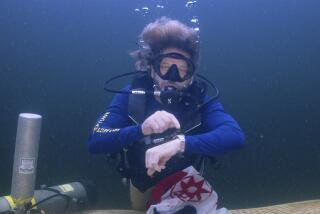Underground Wonderland Lures Divers
- Share via
BONNE TERRE, Mo. — Far beneath the general store and the gas station in this little Midwestern town lies a water wonderland.
Scuba diving, a sport usually associated with the tropics, has come to Missouri. And the “Billion Gallon Lake Resort,” converted from a long-abandoned lead mine, may be its most unusual attraction.
“It’s like diving through a ghost town, or a shipwreck,” says scuba instructor Doug Goergens, who along with his wife, Cathy, owns the flooded mine, now billed as the largest freshwater dive resort in the world. “Or like soaring through a cathedral. It’s an awe-inspiring experience.”
Goergens’ superlatives can be discounted to a certain extent, since he has a vested interest. He says he has invested about $1 million in the project.
But Jacques Cousteau’s son, Jean Michel, was impressed. The son of the man credited as being one of the inventors of scuba (Self-Contained Underwater Breathing Apparatus) in the 1940s, gave the resort rave reviews.
And Skin Diver magazine has touted the mine as “a time capsule, an engineering marvel, and an unbeatable weekend getaway.”
Bonne Terre, or “good earth” in French, is a town of about 3,500 people about 60 miles south of St. Louis. Last year the mine tapped into the landlocked Midwestern scuba market for relatively low-cost, weekend-only forays, attracting 15,000 customers.
The lake was formed when the owners of St. Joseph Mining Co., once the provider of jobs to 5,000, closed operations and shut off the water pumps. Natural seepage of spring and rainwater flooded the mine.
Marian Rivman, a spokeswoman for the Diving Equipment Manufacturers Assn., an organization that monitors the industry, says Bonne Terre is unique.
“People are diving everywhere,” says Rivman, known in the industry as the “Scuba Lady.” “But inland, there’s nothing comparable to the mine. It’s a great destination.”
Beauty, of course, is in the eye of the beholder. And the avid scuba fan has other attractions to explore in the United States, among them shipwrecks off the coast of North Carolina, oil rigs in the Gulf of Mexico or the kelp forests of California.
The Florida Keys are perhaps the prime U.S. destination for the estimated 2.65 million active scuba divers in the United States, offering warm water, coral and fish. Divers also can investigate lakes, quarries and rivers, although visibility often is severely limited.
Such is the case at Lake Norfork, Ark., a 500-mile round trip from St. Louis where Goergens used to take his scuba students.
“Diving can be very, very inconvenient,” Goergens says.
He’s put a lot of work into removing that negative aspect at the Bonne Terre operation, illuminating the mine with 300,000 watts of lighting and installing showers and locker rooms.
The mine, once the world’s largest producer of lead, has the craggy look of a lunar landscape. Jackhammers silent since the mine closed in 1961 jut out of solid rock. Scattered picks, shovels, ladders and helmets also were left behind, and their presence adds to the surreal surroundings.
The lake is pale blue and crystal clear, with visibility more than 100 feet in lighting conditions Goergens describes as “late afternoon,” although it appears to be closer to dusk.
Unlike other diving environs, the subterranean lake is devoid of life forms--no sharks to worry about here--and other distractions such as current, surges or tidal rushes. A constant water temperature of 58 degrees, a little chilly but bearable in a wet suit, makes it a year-round resort.
When Goergens first dived in the mine in 1974 he described it as a “dark, scary place.” He saw potential, though, as a training ground for the 1,200 to 1,500 students his St. Louis company, West End Diving Centers, certifies annually.
It has turned out to be much more. To accommodate the divers that now flock to Bonne Terre, the Goergenses renovated a mansion once owned by the president of the mine and turned it into a country inn.
More to Read
Sign up for The Wild
We’ll help you find the best places to hike, bike and run, as well as the perfect silent spots for meditation and yoga.
You may occasionally receive promotional content from the Los Angeles Times.





